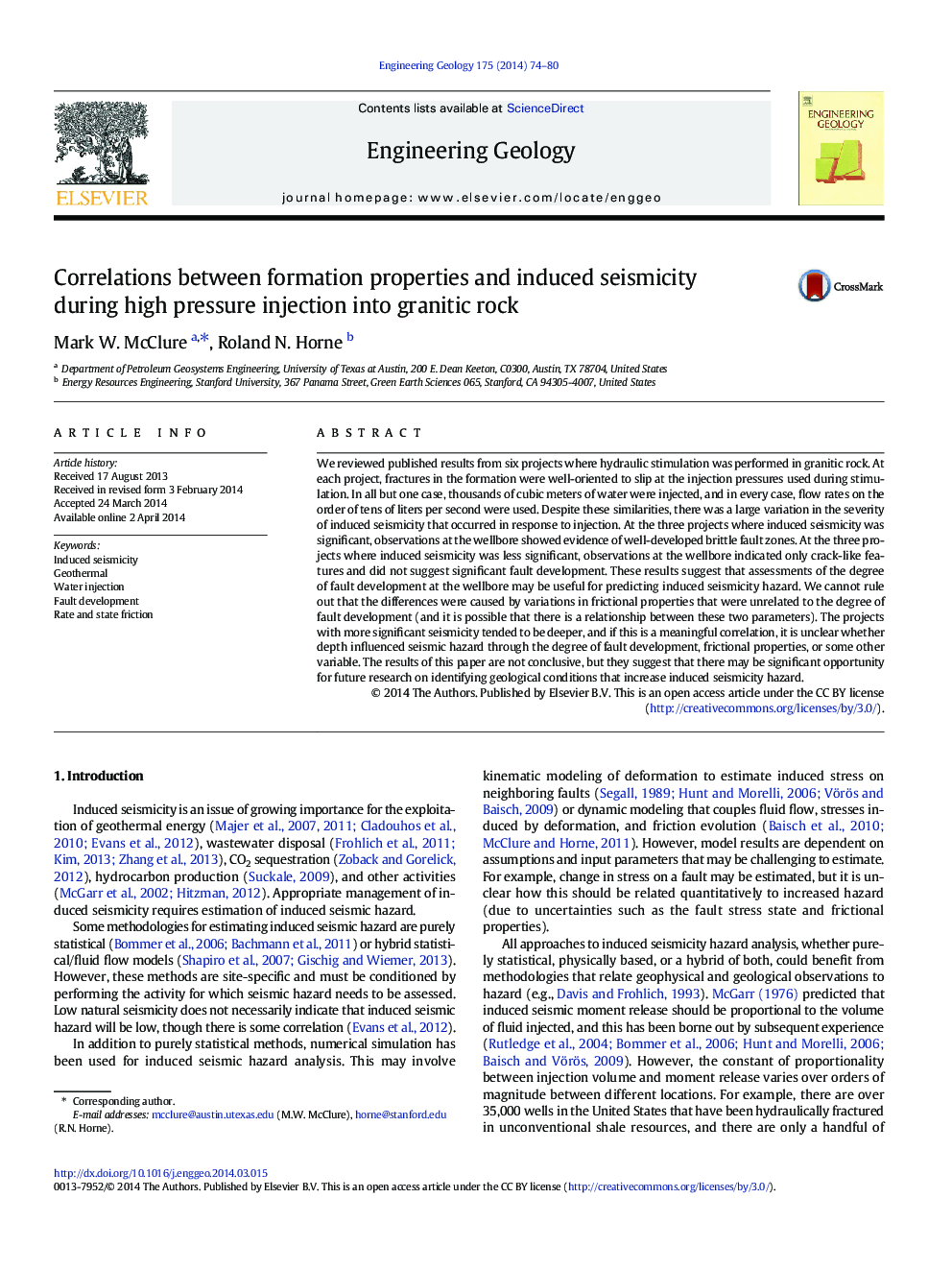| کد مقاله | کد نشریه | سال انتشار | مقاله انگلیسی | نسخه تمام متن |
|---|---|---|---|---|
| 6447947 | 1641809 | 2014 | 7 صفحه PDF | دانلود رایگان |
عنوان انگلیسی مقاله ISI
Correlations between formation properties and induced seismicity during high pressure injection into granitic rock
ترجمه فارسی عنوان
همبستگی بین خواص شکل گیری و لرزه خیزی ناشی از تزریق فشار بالا به سنگ گرانیتی
دانلود مقاله + سفارش ترجمه
دانلود مقاله ISI انگلیسی
رایگان برای ایرانیان
کلمات کلیدی
ترجمه چکیده
ما نتایج منتشر شده از شش پروژه که تحرک هیدرولیکی در سنگ گرانیت انجام شد، مورد بررسی قرار گرفت. در هر پروژه، شکستگی در شکل گیری به سمت لغزش در فشار تزریق استفاده شده در طول تحریک به خوبی بود. در تمام موارد تنها یک مورد، هزاران متر مکعب آب تزریق شد و در هر مورد، میزان جریان به ترتیب ده ها لیتر در ثانیه مورد استفاده قرار گرفت. علی رغم این شباهت ها، شدت لرزه ای ناشی از القایی که در پاسخ به تزریق اتفاق افتاد، تفاوت زیادی وجود دارد. در سه پروژه که لرزه خیزی ناشی از آن قابل توجه بود، مشاهدات در چاه، شواهدی از مناطق گسل شکننده را به خوبی توسعه دادند. در سه پروژه که لرزه خیزی ناشی از آن کم اهمیت تر بود، مشاهدات در چاه، فقط ویژگی های کرکی را نشان داد و نشان داد که توسعه گسل مهم است. این نتایج نشان می دهد که ارزیابی درجه توسعه گسل در چاه، ممکن است برای پیش بینی خطر لرزه ای ناشی از آن مفید باشد. ما نمی توانیم انکار کنیم که تفاوت ها بواسطه تغییرات خواص اصطکاکی که به درجه توسعه گسل مربوط نیستند (و این ممکن است که بین این دو پارامتر وجود داشته باشد). پروژه هایی با لرزه ای قابل توجه تر تمایل دارند عمیق تر شوند و اگر این همبستگی معنی دار باشد، مشخص نیست که آیا عمق تحت تاثیر خطر لرزه ای از طریق درجه توسعه گسل، خواص اصطکاکی و یا برخی از متغیرهای دیگر است. نتایج این مقاله قطعی نیست، اما آنها نشان می دهد که ممکن است برای تحقیقات آینده در مورد شناسایی شرایط زمین شناسی که باعث افزایش خطر لرزه خیزی ناشی از آن می شود، فرصت های قابل توجهی وجود داشته باشد.
موضوعات مرتبط
مهندسی و علوم پایه
علوم زمین و سیارات
مهندسی ژئوتکنیک و زمین شناسی مهندسی
چکیده انگلیسی
We reviewed published results from six projects where hydraulic stimulation was performed in granitic rock. At each project, fractures in the formation were well-oriented to slip at the injection pressures used during stimulation. In all but one case, thousands of cubic meters of water were injected, and in every case, flow rates on the order of tens of liters per second were used. Despite these similarities, there was a large variation in the severity of induced seismicity that occurred in response to injection. At the three projects where induced seismicity was significant, observations at the wellbore showed evidence of well-developed brittle fault zones. At the three projects where induced seismicity was less significant, observations at the wellbore indicated only crack-like features and did not suggest significant fault development. These results suggest that assessments of the degree of fault development at the wellbore may be useful for predicting induced seismicity hazard. We cannot rule out that the differences were caused by variations in frictional properties that were unrelated to the degree of fault development (and it is possible that there is a relationship between these two parameters). The projects with more significant seismicity tended to be deeper, and if this is a meaningful correlation, it is unclear whether depth influenced seismic hazard through the degree of fault development, frictional properties, or some other variable. The results of this paper are not conclusive, but they suggest that there may be significant opportunity for future research on identifying geological conditions that increase induced seismicity hazard.
ناشر
Database: Elsevier - ScienceDirect (ساینس دایرکت)
Journal: Engineering Geology - Volume 175, 10 June 2014, Pages 74-80
Journal: Engineering Geology - Volume 175, 10 June 2014, Pages 74-80
نویسندگان
Mark W. McClure, Roland N. Horne,
